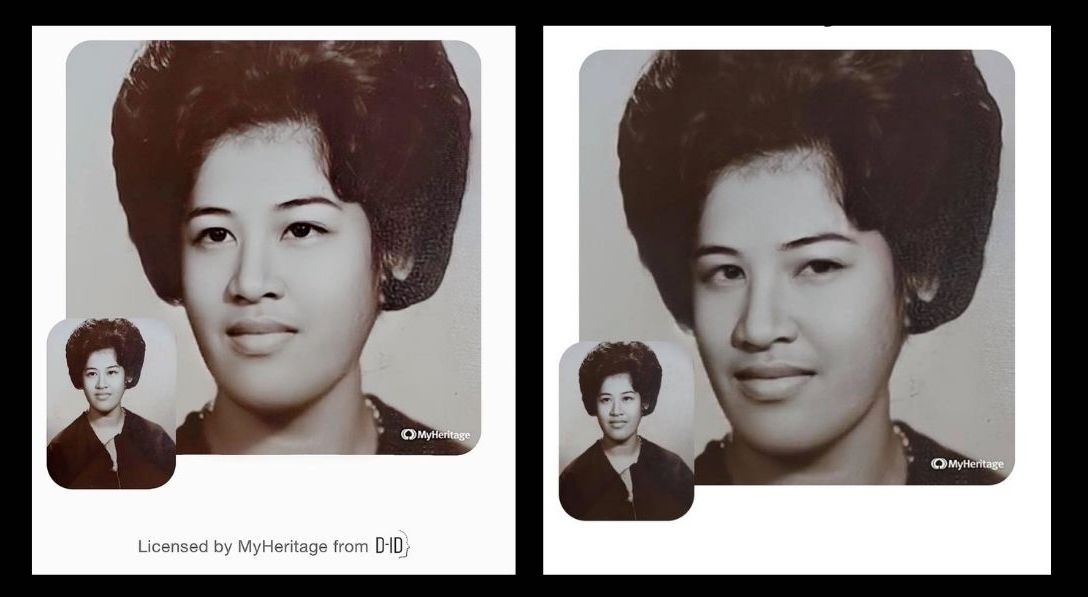I animated a photo of my dead mother with this new technology, and here’s what it felt like
This new tech can animate photos of the dead. Creepy or nostalgic? To be fair, it can animate ANY photo of a person, dead or alive, but people have been using it on loved ones they’ve lost.
The technology comes from My Heritage, a website that traces people’s ancestry and family trees, and is marketed as “Deep Nostalgia,” possibly a riff on deepfake technology.
In the past days, people have been uploading photos of their beloved dead relatives (mostly black and white pictures of their grandparents). But as with any new online generator that's free, the public ran with it. They’ve been animating historical figures like Abraham Lincoln and Jose Rizal; artists like Van Gogh, composers Mozart and Bach and posting them on social media.
Actor Ian McKellen tweeted an animated photo of novelist Oscar Wilde, saying, “Haven’t we always wanted to come face to face with Oscar Wilde? Now we can and see him blink!”
The best pictures to animate? Portraits. It’s so very Harry Potter! When we saw the first movie’s moving images in paintings at Hogwarts Castle and newspapers in 2001, it felt magical. Now it’s here.
If you’re a My Heritage subscriber, you can upload unlimited photos; if you’re not, there’s a limit.
And, no, it doesn’t work on photos of dogs—I tried with a pitbull. The technology detects the human face and applies a fixed sequence of movements such as blinking, tilting of head and smiling.
My Heritage explains that they licensed the technology from D-ID, a company specializing in video reenactment using “deep learning” and integrated it to animate the faces in historical photos and create high-quality, realistic video footage. The feature uses several drivers applied to a face in a still photo to create a short video and “bring your photos to life.”
If the subject on the photo has their mouth closed, the animated smile is also closed—and the movement looks flawless. If the person is smiling with the teeth showing and is not looking directly at the camera, it looks weird.
The most natural and beautiful animations are with the subject looking at the camera, head straight and closed lips. The blinking, head movement, and corners of the mouth slightly lifting in a smile look very smooth.
As if they were alive
The reaction to Deep Nostalgia has been mixed. Some people love it and consider it magical to see their loved ones seemingly come to life even just in still photos. Others find it creepy, spooky.
So I tried it—on a photo of my mother whom I don’t have memories of. My mom died when I was a baby and I only know how she looked from photos.
Last year, my family lost two uncles in the space of four months and our Viber group with my mom’s siblings and their children—my cousins and nieces—has been exchanging tons of old photos (and endless Zoom links for praying the rosary).
Generated with MyHeritage.#DeepNostalgia pic.twitter.com/gNX3wLHsS8
— Andrey Frolov (@kznsq) February 27, 2021
Charles Dickens in colour and moving! This is pretty amazing. @MyHeritage #DeepNostalgia pic.twitter.com/m7zUxSlCah
— Dr Emily Bell (@EmilyJLB) February 28, 2021
I uploaded a black-and-white photo of her—a portrait taken when she became a teacher. After a few seconds, she began to move. Her eyes blinked, her gaze moved from the camera to the side, her head lowered, moved from side to side—and she f*cking smiled!
It was a photo I had seen many times but as much as I dig into the deepest of my memories, I really cannot see her in my mind (I was six months when she died; she was 25).
Looking at the animated image of my mother, I didn’t feel particularly creeped out or nostalgic. I didn’t feel that moved either.
I’ve lived with this empty space in my heart all my life. When I was a child, this space was filled by my maternal grandparents, aunts and uncles, and most of the time it was enough—until it wasn’t. She’s like a brick in my pocket whose weight changes depending on where I am in my life—sometimes heavy, sometimes light, sometimes like it’s not there at all.
I’ve never really been able to answer the question of whether it’s better to have memories and be burdened by loss throughout life or to have no memories at all.

But I loved looking at her animated photo on My Heritage. It made me feel like she was a woman I would have liked had I seen her sitting in a café and we began talking. It felt like she could have been my best girlfriend.
When I sent the link to our family Viber group, her siblings were overcome by nostalgia and tears. She was the eldest of seven and she took care of them, brought them to picnics and the beach. Like my older sister, they too have wonderful memories of her.
I asked them, does this make mommy look creepy?
Her sister in New York said no, she couldn’t stop looking at the picture and it was making her cry to see mommy as though she were alive. “Even at work I look at her photos from time to time.”
Her youngest sister said, “Not creepy at all. I cried looking at this. Your mommy was so beautiful!” Her brother said he became so emotional seeing her as if “she’s alive again after all these decades.” Her brother in Pennsylvania said it was amazing to see her in motion and he remembered how she took care of him when he fell off a bike as a child.
My sister, who doesn’t need this technology to imagine mommy alive in her memories, merely said, “Oh my. So very nice.”
My jealousy jumped out and I wanted to text her, “Bitch.”


